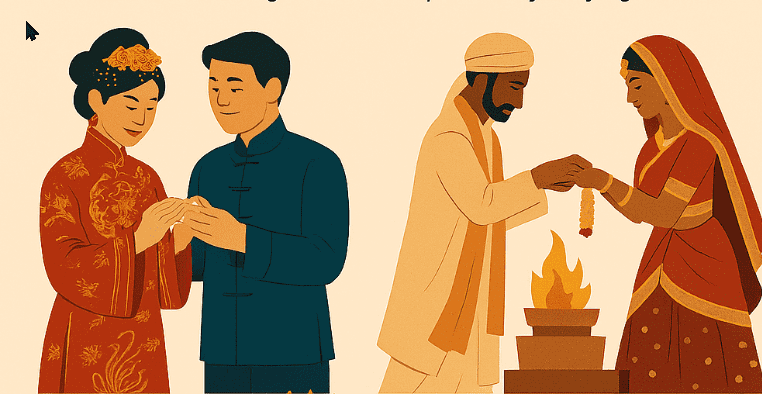
Across every continent, love is celebrated in unique and powerful ways. From whispered vows to sacred ceremonies, these rituals reflect the deep-rooted values of cultures worldwide.
1. Japan: The Art of Gift-Giving
In Japanese culture, romantic expression is often subtle and symbolic. One key ritual is the exchange of giri choco and honmei choco on Valentine’s Day. Women give chocolates—giri (obligation) to colleagues and friends and honmei (true feelings) to romantic interests. Men reciprocate a month later on White Day, often with gifts of greater value.
This ritual emphasizes intention, patience, and emotional depth—core values in Japanese relationships.
2. India: Saptapadi – The Seven Sacred Steps
In Hindu weddings, the bride and groom take seven steps around a sacred fire, each step representing a vow: nourishment, strength, prosperity, health, family, harmony, and loyalty. This ancient ritual, known as Saptapadi, seals the couple’s bond not only to each other but to shared purpose and tradition.
It’s one of the most spiritually rich love rituals still widely practiced today.
3. Kenya: The Maasai Beadwork of Love
Among the Maasai people of Kenya and Tanzania, love is often expressed through beadwork. Women create intricate bead necklaces and bracelets, each color symbolizing different sentiments—red for bravery, white for purity, and blue for loyalty. These are exchanged in courtship or as part of marriage ceremonies.
Through handmade artistry, the Maasai honor both beauty and commitment in their romantic traditions.
4. South Korea: 100-Day Celebrations
In South Korea, couples celebrate relationship milestones meticulously. The 100-day celebration is a major event, often marked by exchanging matching gifts, rings, or going on a special date. This custom symbolizes gratitude and hope for longevity.
It’s a sweet, public acknowledgment of new love and a way to track a relationship’s growth.
5. France: Love Locks and Literary Letters
While Paris is often considered the city of love, the love lock bridges have become one of the most recognizable modern love rituals. Couples inscribe their initials on a padlock, attach it to a bridge, and throw the key into the Seine River as a symbol of everlasting love.
France is also famous for its romantic literary traditions—love letters, poetry, and public declarations of affection are cultural staples.
6. Mexico: Serenades of the Heart
In Mexican culture, romantic courtship often includes the serenata—a serenade performed by a suitor outside their beloved’s window, traditionally with a mariachi band. It’s a bold, heartfelt gesture that blends music, poetry, and courage.
Love in Mexico is passionate and expressive, deeply rooted in cultural pride and community support.
7. Philippines: The Harana Revival
Similar to the Mexican serenade, the harana was a pre-colonial Filipino courtship ritual involving serenading a woman at night. While the tradition has been passed down in modern times, it’s now experiencing a revival through music festivals and cultural events.
The harana reflects respect, admiration, and a gentle, poetic form of wooing.
8. Norway: Wooden Love Spoons
In Norwegian tradition, as well as in parts of Wales, handcrafted wooden love spoons were historically given as romantic tokens. The designs were symbolic: hearts for love, chains for togetherness, wheels for support. Today, they are often gifted at weddings and anniversaries.
This folk tradition celebrates the merging of craftsmanship and sentiment in romantic relationships.
9. Ethiopia: Lip Plates and Courtship in the Mursi Tribe
Among the Mursi people of Ethiopia, young women wear large lip plates as a symbol of identity, strength, and beauty. While controversial from an outsider’s perspective, these practices are tied to deep cultural meaning and rites of passage that include complex courtship rituals.
This ritual emphasizes the role of tradition and endurance in defining beauty and relationship roles.
10. Jewish Tradition: Breaking the Glass
At the end of a traditional Jewish wedding, the groom breaks a glass underfoot. This act carries multiple meanings—mourning past struggles, acknowledging life’s fragility, and symbolizing a permanent change. It’s immediately followed by guests shouting, “Mazel tov!”
It’s one of the most well-known love rituals in the world, tying personal joy to collective memory and resilience.
Love Rituals in a Modern Context
In today’s interconnected world, love rituals are evolving. Social media anniversaries, engagement-reveal parties, and destination weddings reflect a blend of old and new. Yet, the heart of these practices remains the same: a desire to mark love as sacred and worthy of celebration.
From traditional ceremonies to TikTok tributes, these evolving customs continue to honor romance in meaningful ways.
Conclusion: What Rituals Teach Us About Love
Cultural love rituals aren’t just charming traditions—they are windows into the soul of a society. They teach us that love can be loud or quiet, spiritual or playful, private or performed. What remains constant is humanity’s deep-rooted desire to express affection, bond with others, and honor emotional commitment through shared symbols and ceremonies.
Whether you’re exchanging gifts, singing love songs, or taking sacred vows, love rituals remind us that romance is not just a feeling—it’s a practice.





